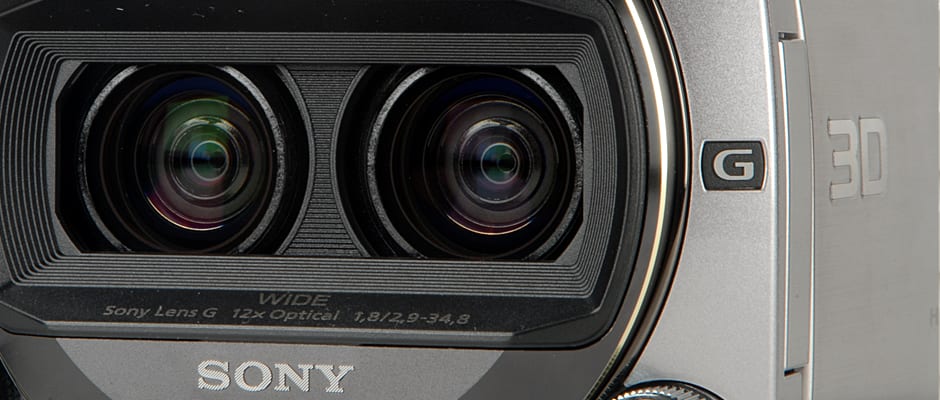Pros
Cons
Introduction
Lens & Imaging System
{{section_header}}{{section.name}}{{/section_header}}

The HDR-TD10 has different focal ranges depending whether you're shooting 3D or 2D video. In the tables below, we have listed the lens specs for 3D recording because that's what we feel most people are going to be interested in with the HDR-TD10.
Front
{{section_header}}{{section.name}}{{/section_header}}
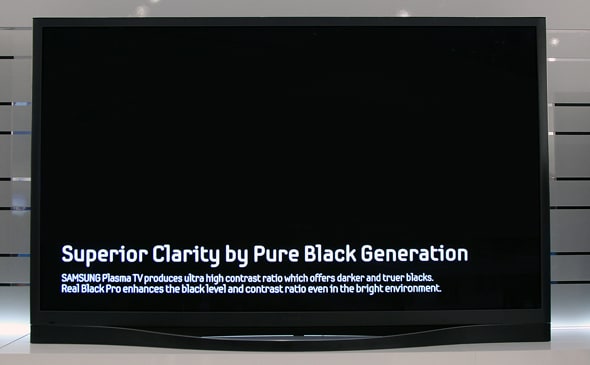
In the front of the HDR-TD10 you'll see two side-by-side lenses, which are necessary to capture a 3D image. This is not simply a conversion lens or an attachment—these two lenses will always be present whether you're shooting 2D or 3D content.
Right
{{section_header}}{{section.name}}{{/section_header}}
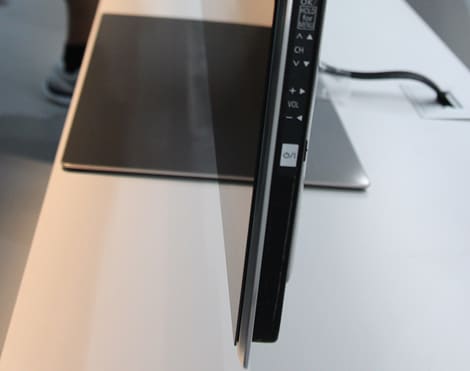
The right of the camcorder features a padded hand strap and a comfortable, textured surface. Unfortunately, the camcorder's thick size makes it difficult to get a good grip on the HDR-TD10.
Back
{{section_header}}{{section.name}}{{/section_header}}
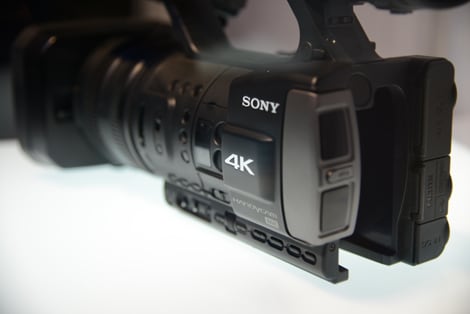
The back has ports and the battery compartment, as well as a switch to alternate between 2D and 3D recording.
Left
{{section_header}}{{section.name}}{{/section_header}}
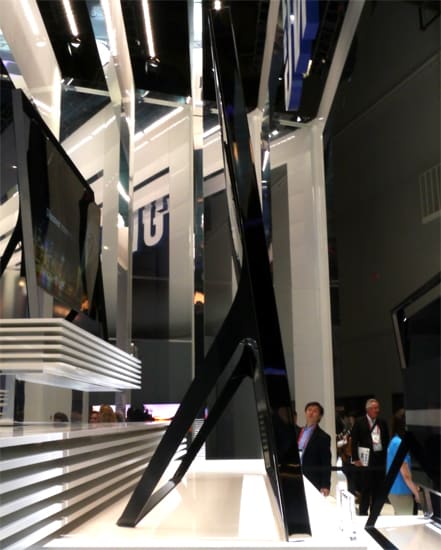
The left looks sleek and stylish on the HDR-TD10, but the camcorder does have some more controls inside the LCD cavity (when you open the LCD panel).
Top
{{section_header}}{{section.name}}{{/section_header}}

From the top, you can really see how thick the HDR-TD10 is. The surface of the top is nearly wide enough to support a spirited game of tiddlywinks, or perhaps a quick round of shuffleboard.
Bottom
{{section_header}}{{section.name}}{{/section_header}}
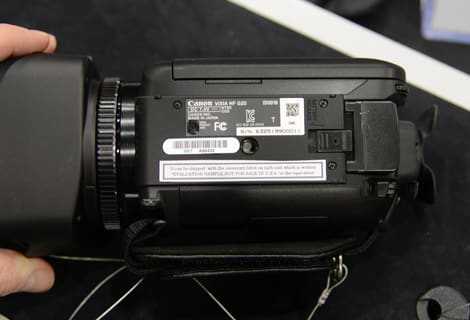
Like the top, the bottom of the TD10 is wide, flat, and boring. You do get a good view of built-in microphone, though.
Compression
{{section_header}}{{section.name}}{{/section_header}}
Most record modes on the HDR-TD10 use AVCHD recording, just like on previous Sony HD camcorders. The HDR-TD10 does have some new compression features, however, thanks to the presence of 3D recording and the camcorder's 1080/60p mode. Since the "Double Full HD 3D" option on the camcorder cannot work with AVCHD, Sony had to employ a new original format compression system called MVC. This format, which is based on MPEG-4, is also used for the camcorder's 1080/60p record mode.
Read more about the advantages and disadvantages of different compression types.
Media
{{section_header}}{{section.name}}{{/section_header}}
The HDR-TD10 has 64GB of built-in flash memory, which is good for recording up to five hours of 3D video in HD. The camcorder also has a versatile memory card slot that works with a variety of memory cards: SD, SDHC, SDXC, or Memory Stick PRO Duo.
Read more about the advantages and disadvantages of different media types.

Editing
{{section_header}}{{section.name}}{{/section_header}}
We're hoping the provided software that ships with the HDR-TD10 allows you to import and work with 3D video as well as 60p footage shot with the camcorder. Sony wasn't able to go into too many details about the software that comes with the TD10, so it's still a bit of a mystery how well it will work with the new compression systems and shooting modes the TD10 has to offer.
Of course, this is also an issue if you're a dedicated user of a third-party editing program. You'll have to make sure whatever software you use can work with 3D video and the like before you set out and buy the HDR-TD10 with the expectation that you'll be able to work with the footage.
Auto Mode
{{section_header}}{{section.name}}{{/section_header}}
The Sony HDR-TD10 has a generous auto mode that is similar to what we've seen on Sony camcorders for the past couple of years. The camcorder's Intelligent Auto controls, which automatically select a scene mode for the user, are even functional during 3D shooting. 3D shooting is essentially automated for the most part on the TD10, as you cannot adjust any advanced manual controls when shooting 3D.

Low Light Modes
The TD10's Low Lux mode is not available during 3D recording, but the mode will give a boost in low light when shooting 2D. Low Lux both lowers the minimum shutter speed (to 1/30 of a second) and provides an increase in ISO in order to enhance brightness in low light situations.
Scene Modes
The array of scene modes on the TD10 are also only selectable during 2D recording. Having the camcorder automatically select scene modes with Intelligent Auto is possible in 3D mode, however.
Zoom
Zoom Ratio
{{section_header}}{{section.name}}{{/section_header}}
Zoom is possible during both 3D and 2D recording, but the amount of zoom you get depends on what kind of video your shooting. In 3D mode the camcorder allows for 10x optical zoom, but this zoom increases to 12x optical in 2D mode. You can also turn on extended zoom to increase the magnification up to 17x.
Focus
{{section_header}}{{section.name}}{{/section_header}}
Focus can be set manually on the TD10 using the touchscreen or the camcorder's front-mounted control dial. And let's not forget about Sony's great autofocus tracking feature that allows you to tap on a subject within the recording frame and have the camcorder keep them in focus automatically as they move about. This tracking focus feature is not available in 3D mode.
Exposure
{{section_header}}{{section.name}}{{/section_header}}
You can perform an auto exposure shift on the HDR-TD10 as well as manually lowering or increasing the exposure levels using the touchscreen (or control dial). The spot exposure feature, which allows you to tap part of the LCD to automatically expose that area of the frame, is not functional in 2D record mode.
Aperture
{{section_header}}{{section.name}}{{/section_header}}
Last year Sony began to offer aperture and shutter speed control on its high-end camcorders. The HDR-TD10 continues this trend by allowing manual control of these features using the control dial on the front of the camcorder. Unfortunately, none of these manual controls work in 3D record mode.
Shutter Speed
{{section_header}}{{section.name}}{{/section_header}}
Just like aperture, shutter speed can be controlled manually using the control dial on the front of the HDR-TD10. Again, this manual control is for 2D recording only.
White Balance
{{section_header}}{{section.name}}{{/section_header}}
The HDR-TD10 has a few white balance presets and a traditional manual white balance function. It appears that these presets and manual white balance controls will work for both 2D and 3D recording.
3D Lens
{{section_header}}{{section.name}}{{/section_header}}
The HDR-TD10 comes with a built-in 3D lens—not a detachable conversion lens like Panasonic uses on the HDC-SDT750. Because of this, you don't have to calibrate the lens before recording 3D. Everything is already setup and ready to go as soon as you switch over to 3D record mode. This is a great boon for casual users, but it does also give you less control and versatility. The advantage of a removable 3D lens is that you can take it off when you want to record 3D and you don't have to lug around a big camcorder with two lenses.

The dual lens system makes 3D recording a reality on the Z10000.
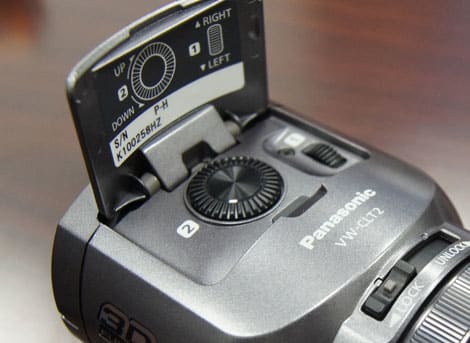
3D Controls
{{section_header}}{{section.name}}{{/section_header}}
When shooting 3D, the HDR-TD10 does allow for a few controls. Most important is a 10x optical zoom capability in 3D mode. This zoom is slightly smaller than what you get in 2D mode (12x optical zoom), but we still think it is very impressive. The camcorder's Intelligent Auto scene selection function, as well as its optical image stabilization work in 3D mode as well.
{{product.manufacturer_specs['FI 3D Physical Controls Image']}}{{product.manufacturer_specs['FI 3D Physical Controls Image 2']}}
{{product.manufacturer_specs['FI 3D Controls Menu Image']}}
3D Playback
{{section_header}}{{section.name}}{{/section_header}}
The most important thing to mention about 3D playback on the TD10 is the camcorder's glasses-free 3D LCD. We go into this function in more detail in the Handling & Use section of this review, but we'll give you a brief rundown here as well. In short, we were not impressed with the glasses-free LCD capability. The images often had plenty of ghosting and blur when we watched them on the tiny screen and, at times, the LCD's 3D function didn't appear to work at all. Again, this may be a problem with the fact that the TD10's on the floor at CES were still pre-production releases, but the 3D content on the LCD really didn't look very good to our eyes. Of course, you can always connect the HDR-TD10 to a 3D HDTV and watch your content there—with 3D glasses, of course.
{{product.manufacturer_specs['FI 3D Playback Menu Image']}}
Ease of Use
{{section_header}}{{section.name}}{{/section_header}}
By some accounts, the 3D mode on the HDR-TD10 is easy to use. There's no lens calibration or special 3D settings that need to be turned on—you simply flick the switch on the back of the camcorder from 2D to 3D. This is a far easier setup than we saw on the Panasonic HDC-SDT750, which required lots of setup with its 3D conversion lens.
That being said, the HDR-TD10 can be a terribly difficult camcorder for recording 2D. It's gigantic frame and extra features (because of 3D mode) make for a more confusing camcorder. It's not terribly difficult, but it is definitely far more daunting than a regular camcorder that doesn't offer a 3D record mode.
Handling
{{section_header}}{{section.name}}{{/section_header}}
The HDR-TD10 does not handle like your every-day consumer camcorder. For starters, it's roughly twice the size and twice the weight as a normal consumer camcorder—and you notice this difference right away. It's not that the camcorder feels uncomfortable in your hand, it's just that it doesn't really feel right. It is impossible to wrap your fingers all the way around the TD10's sprawling top, which means you can never get a perfect grip on the device. However, we do give Sony kudos for including a good, padded handstrap with the TD10.
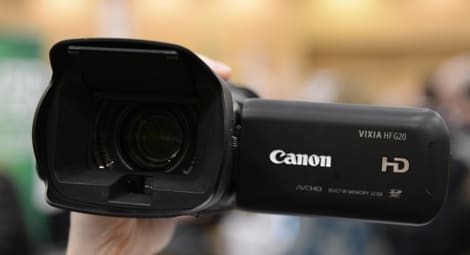
The problem with the HDR-TD10 is that you would never want a camcorder this large unless you're entirely dedicated to shooting 3D video and only 3D video. The camcorder is far to large as a regular 2D recording device, especially when you consider how small most HD camcorders have become. For this reason, we actually like the setup on Panasonic's 3D camcorders (like the new HDC-TM900 or last year's HDC-SDT750). With Panasonic's models, you can record regular footage easily because the 3D conversion lens is removable. With the Sony HDR-TD10 you are always stuck with a big, bulky camcorder whether you're shooting 3D or not.

We do like the large LCD on the HDR-TD10, and the camcorder's touchscreen interface works fairly well, but the glasses-free 3D on the LCD isn't very effective. We should note, however, that the TD10 models we played with at CES were still pre-production models. It is possible that some of the issues we had with the LCD will be fixed by the time the camcorder is available to consumers.

Stabilization
{{section_header}}{{section.name}}{{/section_header}}
The HDR-TD10 has an optical image stabilization mode (OIS) with an additional active mode setting. The feature works with both 2D and 3D recording.
Portability
{{section_header}}{{section.name}}{{/section_header}}
Since the TD10 has two lenses and two image sensors, the camcorder is by no means a slender or compact device. In fact, it is one of the largest consumer camcorders on the market it terms of weight and size. Still, the HDR-TD10 isn't nearly as bulky as camcorders from days of yore, and it is roughly the same size as some of the compact professional camcorders that have been announced by a number of manufacturers. The question is: will consumers be okay with sacrificing portability in sake of having 3D recording? We're not so sure about this, especially when you have far more compact options available from Panasonic. The HDR-TD10's 3D performance is going to have to be stellar in order for the camcorder to make up for its large and heavy design.
Battery
{{section_header}}{{section.name}}{{/section_header}}
The camcorder comes with a 7.2-volt battery pack with the model number NP-FV70. This provided battery is fairly large and it does add some significant weight to the camcorder. There's a smaller battery pack, the NP-FV50, as well as a larger pack, the NP-FV100, that can both be used with the HDR-TD10.

LCD & Viewfinder
{{section_header}}{{section.name}}{{/section_header}}
The LCD on the HDR-TD10 is not only large (3.5-inches), but it also offers glasses-free 3D capability. Unfortunately, we were not impressed with the ability of the LCD to display 3D content. Viewing short clips on the screen while we were at CES, we consistently noticed blur and ghosting on recorded 3D content. However, for viewing 2D video the screen looked great, and its touchscreen interface worked well for the most part.

The HDR-TD10 does not have an electronic viewfinder, which is actually somewhat of a surprise considering the camcorder's large frame and high cost. Sony does have viewfinders on some of its high-end consumer camcorders, but the feature is not found on its mid-range options (this is the case for most manufacturers).
Given the issues we had with the camcorder's LCD, we wonder if a 3D viewfinder would have been a possibility on the HDR-TD10. Perhaps the tiny screen size and constrained viewing angle that are required by viewfinders would have made for a better 3D-viewing experience than the glasses-free LCD. Not that you would want to watch all your 3D content on a tiny viewfinder... we just think it sounds like an option worth exploring.


Menus
Audio Features
{{section_header}}{{section.name}}{{/section_header}}
The HDR-TD10 has a built-in microphone that can record 5.1-channel surround sound, and it also features an external mic and headphone jack. The inclusion of an external mic input is a significant move for Sony, as the company was not including that feature on many camcorders in the past. This year, however, mic inputs can be found on many of Sony's new models.
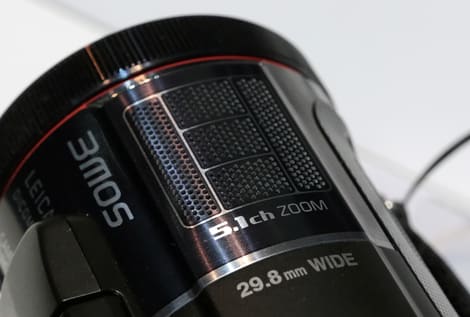
Connectivity
Still Features
Other Features
{{section_header}}{{section.name}}{{/section_header}}
Golf Shot
Takes slow motion video that is meant for analyzing a golf swing, but it can probably be used for other stuff as well—use your creativity!
Video Light
The LED video light on the front of the camcorder doesn't provide much light, but it will help if you're trying to get a viable image in low light.
Conclusion
Having the ability to record 3D video is something that is sure to titillate many consumers, especially the geeks among us. But we need to ask how important the feature really is. Is it more important than comfort and ease of use? Is it more important than portability? Should 2D capabilities be sacrificed to make way for advanced 3D options?
The HDR-TD10 puts 3D recording in the forefront. The dual lens system requires no calibration for recording 3D, and the fact that the camcorder allows for 10x optical zoom in 3D mode is rather impressive. This makes things simple and easy for those who want to record 3D video, but it puts a significant strain on the camcorder in terms of 2D recording. The HDR-TD10 is bulky, heavy, and not comfortable to wield—and those are things that most camcorder users are not willing to accept this day in age. Simply put, unless you're planning on shooting mostly 3D content with the HDR-TD10, the camcorder is not worth your money. There are plenty of better, and more compact, 2D camcorders on the market.
All that being said, we expect the HDR-TD10 to do quite well in our 3D testing. The Panasonic HDC-SDT750 did a decent job producing a 3D effect in our labs, but we're hoping of even better performance from the Sony due to its dual lens and sensor setup. If the Sony HDR-TD10 does blow us away with its 3D performance, we may revise our critique of the camcorder. But, for now, we remain disappointed with the TD10 based on design, handling, and the poor quality of the glasses-free 3D LCD.
Photo Gallery
{{photo_gallery "FI Lens Image", "FI Front Image", "FI Right Image", "FI Back Image", "FI Left Image", "FI Left Open Image", "FI Top Image", "FI Bottom Image", "FI Media Image", "FI Easy Mode Image", "FI Zoom Image", "FI Zoom Image 2", "FI 3D Lens Image", "FI 3D Lens Image 2", "FI 3D Physical Controls", "FI 3D Physical Controls 2", "FI Handling Image", "FI Handling Image 2", "FI Handling Image 3", "FI Battery Image", "FI LCD Image", "FI Viewfinder Image", "FI Viewfinder Image 2", "FI Playback Image", "FI Mic Image", "FI Flash Image", "FI Photo Mode Image", "FI Ports Image 1", "FI Ports Image 2", "FI Ports Image 3", "FI Ports Image 4", "FI Ports Image 5", "FI Ports Image 6"}}
Specs
{{manufacturer_specs_table}}
Meet the tester
Jeremy is the video expert of our imaging team and Reviewed.com's head of video production. Originally from Pennsylvania and upstate NY, he graduated from Bard college with a degree in film and electronic media. He has been living and working in New England since 2005.
Checking our work.
Our team is here to help you buy the best stuff and love what you own. Our writers, editors, and experts obsess over the products we cover to make sure you're confident and satisfied. Have a different opinion about something we recommend? Email us and we'll compare notes.
Shoot us an email